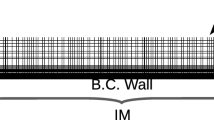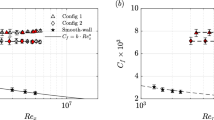Abstract
Roughness effects are one of the main challenges of the prediction of ship resistance using traditional model tests and extrapolation procedures. Computational Fluid Dynamics (CFD) can play an important role in the improvement of empirical correlations. Nowadays, most CFD RANS solvers use an equivalent sand-grain roughness height to model roughness effects. Therefore, the simulation of roughness effects includes two main challenges: estimate the equivalent sand-grain roughness height that corresponds to a given average roughness height typically used to characterize the roughness of ships; include sand-grain roughness effects in the most accurate RANS turbulence models for the simulation of ship flows, as for example the \(k-\omega \) SST eddy-viscosity model. In this work, the flows around different geometries (flat plate, submarine and two ships) at full scale Reynolds numbers (\(10^8\) to \(10^9\)) are simulated with RANS solvers using the \(k-\omega \) SST eddy-viscosity model. Roughness effects are included in the k and \(\omega \) boundary conditions for values of the sand-grain roughness height covering hydraulically smooth and fully rough surfaces. It is shown that with the proper scaling, the increase of the friction resistance coefficient with the sand-grain roughness height is equivalent for the four geometries tested. Conversion of average roughness height to sand-grain roughness is assessed by comparing CFD results with Bowden and Davison and Townsin et al. empirical correlations. Results of the simulations show the best agreement with the Townsin et al. correlation with a small variation of the ratio between average roughness and sand-grain roughness heights.













Similar content being viewed by others
Notes
P is the relative pressure with the hydrostatic pressure as the reference and it contains the 2/3k contribution of the normal Reynolds stresses, where k is the turbulence kinetic energy.
Naturally, when \(h_{sg}\) is used for the reference length the equation does not apply to the hydraulically smooth regime.
The exponent 0.7 was selected to obtain the best agreement between the results of the four geometries tested.
We have also tested the Himeno correlation, but the values of \(\alpha \) obtained do not make sense.
References
Andersson J, Oliveira DR, Yeginbayevab I, Leer-Andersen M, Bensow RE (2020) Review and comparison of methods to model ship hull roughness. Appl Ocean Res 99:102119
Aupoix B (2014) Wall roughness modelling with k-w STT model. In: 10th International ERCOFTAC Symposium on Engineering Turbulence Modelling and Measurements, Marbella
Bowden BS, Davison NJ(1974) Resistance increments due to hull roughness associated with form factor extrapolation methods. National Physical Laboratory (NP) Ship Technical Manual 3800
Carrica PM, Kerkvliet M, Quadvlieg FHHA, Pontarelli M and Martin JE (2016) Simulations and experiments of a maneuvering generic submarine and prognosis for simulation of near surface operation. In: 31st Symposium on Naval Hydrodynamics, Montery
Cebeci T, Bradshaw P (1977) Momentum transfer in boundary layers. Hemisphere Publishing Corporation, New York
Churchill SW (1993) Theoretically based expressions in closed form for the local and mean coefficients of skin friction in fully turbulent flow along smooth and rough plates. Int J Heat Fluid Flow 14(3):231–239
Eça L, Hoekstra M (2004) On the grid sensitivity of the wall boundary condition of the \(k-\omega \) model. J Fluids Eng 126(6):900–910
Eça L, Hoekstra M (2008) The numerical friction line. J Mar Sci Technol 13(4):328–345
Eça L, Hoekstra M (2010) Near-wall profiles of mean flow and turbulence quantities predicted by eddy-viscosity turbulence models. Int J Numer Meth Fluids 63:953–988. https://doi.org/10.1002/fld.2115
Eça L, Hoekstra M (2011) Numerical aspects of including wall roughness effects in the SST \(k-\omega \) eddy-viscosity turbulence model. Comput Fluids 40(1):299–314
Eça L, Hoekstra M, Raven HC (2010) Quantifying roughness effects by ship viscous flow calculations. 28th Symposium on Naval Hydrodynamics. Pasadena, California
Eça L, Pereira FS, Vaz G (2018) Viscous flow simulations at high Reynolds numbers without wall functions: Is y\(^+\simeq \)1 enough for the near-wall cells? Comput Fluids 170:157–175
Hellsten A, Laine S (1998) Extension of the \(k-\omega \) shear-stress transport turbulence model for rough-wall flows. AIAA J 36:1728–1729
Hino T, Stern F, Larsson L, Visonneau M, Hirata N, Kim J (eds) (2016) Numerical Ship Hydrodynamics, an assessment of the Tokyo 2015 Workshop. Tokyo
Hoekstra M and Eça L (1998) PARNASSOS: an efficient method for ship stern flow calculation, Third Osaka Colloquium on Advanced CFD Applications to Ship Flow and Hull Form Design, Osaka, Japan
ITTC (2008) The resistance committee final report and recommendations to the 25th ITTC. Fukuoka, Japan
Knopp T, Eisfeld B, Calvo JB (2009) A new extension for \(k-\omega \) turbulence models to account for wall roughness. Int J Heat Fluid Flow 30:54–65
Larsson L, Stern F, Bertram V (eds) (2002) Gothenburg 2000—a workshop on numerical ship hydrodynamics. Chalmers University of Technology, Gothenburg
Larsson L, Stern F, Visonneau M (eds) (2010) Gothenburg 2010—a workshop on numerical ship hydrodynamics. Chalmers University of Technology, Gothenburg
Menter FR (1994) Two-equation eddy-viscosity turbulence models for engineering applications. AIAA J 32(8):1598–1605
Mills AF, Hang X (1983) On the skin friction coefficient for a fully rough flat plate. J Fluids Eng 105(3):364–365
Pereira FS, Eça L, Vaz G, Kerkvliet M (2019) Application of second-moment closure to statistically steady flows of practical interest. Ocean Eng. https://doi.org/10.1016/j.oceaneng.2019.106372
Pimenta MM, Moffat RJ and Kays WM (1975) The turbulent boundary layer: an experimental study of the transport of momentum and heat with the effect of roughness. Department of Mechanical Engineering, Stanford University. ReFRESCO, (2021), https://www.marin.nl/facilities-and-tools/software/refresco
Schultz MP (2007) Effects of coating roughness and biofouling on ship resistance and powering. Biofouling 23(5–6):331–41. https://doi.org/10.1080/08927010701461974
Song S, Ravenna R, Dai S, De Marco Muscat-Fenech C, Tani G, Demirel YK, Atlar M, Day S, Incecik A (2021) Experimental investigation on the effect of heterogeneous hull roughness on ship resistance. Ocean Eng. https://doi.org/10.1016/j.oceaneng.2021.108590
Song S, Demirel YK, De Marco Muscat-Fenech C, Sant T, Villa D, Tezdogan T, Incecik A (2021) Investigating the effect of heterogeneous hull roughness on ship resistance using CFD. J Mar Sci Eng 9(2):202. https://doi.org/10.3390/jmse9020202
Townsin RL, Medhurst JS, Hamlin NA and Sedat BS (1984) Progress in calculating the resistance of ships with homogeneous or distributed roughness. NECIES Centenary Conference in Marine Propulsion, Newcastle upon Tyne, United Kingdom
Toxopeus SL, Bettle MC, Uroić T, Guilmineau E, Bordier L, Olbert G, Bensow RE, Petterson K, Dikbaş E, Feldman J, Pattenden R (2019) NATO AVT-301 collaborative exercise: CFD predictions for BB2 generic submarine, phase 0—pre-test computations, NATO STO AVT-307 Research Symposium on Separated Flow: Prediction. Measurement and Assessment for Air and Sea Vehicles, Trondheim
Wilcox DC (2006) Turbulence modeling for CFD-DCW industries. 3rd Edition
Wilcox DC (1988) Reassessment of the scale-determining equation for advanced turbulence models. AIAA J 26:1299–1310
Yeginbayeva IA, Atlar M (2018) An experimental investigation into the surface and hydrodynamic characteristics of marine coatings with mimicked hull roughness ranges. Biofouling 34(9):1001–1019. https://doi.org/10.1080/08927014.2018.1529760
Author information
Authors and Affiliations
Corresponding author
Additional information
Publisher's Note
Springer Nature remains neutral with regard to jurisdictional claims in published maps and institutional affiliations.
Rights and permissions
Springer Nature or its licensor holds exclusive rights to this article under a publishing agreement with the author(s) or other rightsholder(s); author self-archiving of the accepted manuscript version of this article is solely governed by the terms of such publishing agreement and applicable law.
About this article
Cite this article
Eça, L., Starke, A.R., Kerkvliet, M. et al. On the contribution of roughness effects to the scaling of ship resistance. J. Ocean Eng. Mar. Energy 8, 539–551 (2022). https://doi.org/10.1007/s40722-022-00264-9
Received:
Accepted:
Published:
Issue Date:
DOI: https://doi.org/10.1007/s40722-022-00264-9




